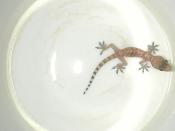There are about 750 species of geckos. The gecko is a small and harmless creature. These nocturnal reptiles have soft skin, and a short, stout body carrying a large head. These facts aren't what is truly interesting about the gecko. The gecko has weak limbs equipped with suction-padded digits that enable them to effortlessly climb along incredibly smooth ceilings. This ability was previously believed to be the work of capillary action in the gecko's toes, but upon recent discoveries made by U.S. scientists these magnificent little lizards utilize electrostatic forces to climb on these surfaces. Geckos have millions of microscopic hairs sprouting from their feet. These hairs are called setae, and they can split into as many as 1,000 tiny hairs. These tiny hairs are each capped with a triangular pad called a spatulae. These spatulae are roughly about the size of a small bacterium. These recent findings established that geckos use Van der Waals forces to scale even ceilings made of marble.
Van der Waals forces are weak electrostatic attractions between adjacent molecules that arise from fluctuations in the positions of their electrons. Scientists discovered this by placing the gecko's feet on both hydrophillic, water-attracting, and hydrophobic, water-repelling, wafers and they measured the forces exerted by their feet. The gecko's feet were equally attracted to both surfaces, but when placed on surfaces with low molecular levels the feet slipped. The scientists believe that the geometry of the hairs on the gecko's toes makes the contact area between the toes and the surface large enough for the Van der Waals attraction to become significant.
This new discovery has led many scientists and engineers to think about using these new findings to create a revolutionary adhesive material. Geckos are now proving themselves as not only useful pets that eat unwanted...



Sources?
Or were you born knowing all this?
0 out of 0 people found this comment useful.